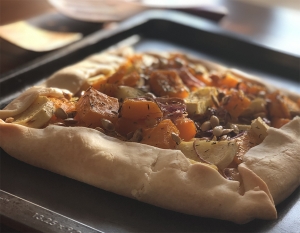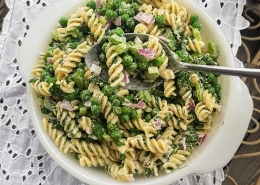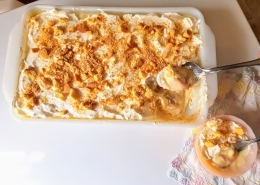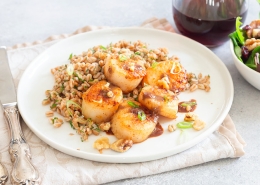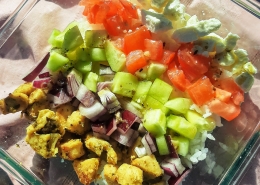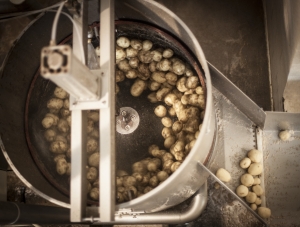 At their essence, potato chips contain three ingredients: potatoes, oil, and salt. They’re one of America’s favorite snacks year after year, and the crowded market reflects that: countless flavors and varieties, too many brands to count, massive marketing campaigns, and more. So how can a small producer hope to compete? How do they set themselves apart? If you ask Sarah Cohen, President of Route 11 Potato Chips, she’ll say, “Less is more.”
At their essence, potato chips contain three ingredients: potatoes, oil, and salt. They’re one of America’s favorite snacks year after year, and the crowded market reflects that: countless flavors and varieties, too many brands to count, massive marketing campaigns, and more. So how can a small producer hope to compete? How do they set themselves apart? If you ask Sarah Cohen, President of Route 11 Potato Chips, she’ll say, “Less is more.”
The folks at Route 11 have found success with that motto since their founding in 1992, and their resume shows it: a Ben & Jerry’s ice cream collab, a name drop from Oprah, a featured ingredient in the cookbook of two star Michelin Chef José Andrés . . . The list goes on.
When a food product has so few ingredients, quality becomes even more important. “With snack foods, manufacturers look for what’s cheapest,” Cohen says. That’s not the case at Route 11, where they’ve been using organic produce since day one. “The quality of the potato is essential,” she says. “The better potatoes we get, the better chips we’ll make. All of our potatoes come from the east coast, all the way from Florida to New York. We work with a local grower in Harrisonburg and we get close to 1,000,000 pounds of potatoes from him every season . . . The beauty of a kettle chip is that it really reflects the potato.”
But to stand a chance against large brands, that commitment to quality must extend beyond potatoes. Salt is often taken for granted in cooking and commercial food production, but at Route 11, it’s an opportunity to create an even better product. They use a mineral salt mined in Redmond, Utah, the standard salt for most Route 11 flavors. “What we love about Real Salt is that—first of all—it’s really delicious. And it’s unrefined, which means that it still has all of the 70-plus minerals inherent to salt. Most commercial salt is just sodium chloride, and is missing all the mineral goodness essential to good health.”
Their brand new Salt & Pepper flavor uses salt from J. Q. Dickinson, which is sourced from the Iapetus Ocean, an ancient body of seawater that lies  isolated below the Appalachian Mountains in West Virginia, about 250 miles west of the Route 11 factory. “We were playing around with creating the Salt & Pepper flavor for years,” Cohen says. “There are about 20 salt and pepper chips on the market, most of them containing 15-plus ingredients. Our goal was to do it with just salt and pepper. We just couldn’t find a good balance until we discovered the JQD salt. As soon as we tasted it, we knew . . . We consider this the best flavor we’ve ever developed.”
isolated below the Appalachian Mountains in West Virginia, about 250 miles west of the Route 11 factory. “We were playing around with creating the Salt & Pepper flavor for years,” Cohen says. “There are about 20 salt and pepper chips on the market, most of them containing 15-plus ingredients. Our goal was to do it with just salt and pepper. We just couldn’t find a good balance until we discovered the JQD salt. As soon as we tasted it, we knew . . . We consider this the best flavor we’ve ever developed.”
Route 11’s production process is as dedicated to sustainability as it is to quality. When they rebuilt their factory in 2008, they didn’t cut down trees; they planted them. Sustainability is a focal point at every step of production from the moment the potatoes arrive from the farm: The residual dirt washed off the potatoes is collected by a filter to be used as topsoil. After the potatoes are peeled—at a mind-boggling rate of 50 pounds per second—the skins and rejects are sent half a mile up the road to a farmer whose cow herds have developed an affinity.
Next, their slicer, which can process 100 pounds in 42 seconds, prepares the potatoes for the slow-cooking process in the kettle. “The key is removing moisture,” Cohen says. “We cut the potatoes to a deliberate thickness. We want them crunchy but not too hard.” This combination of factors creates irregularly shaped chips, some flat, some folded in half or even in quarters: “It takes Frito Lay about 30 seconds to cook a batch, where as it takes us close to 8 minutes, what would be considered an eternity when it comes to mass production . . . There’s more opportunity in our process for folding and undulating.” These irregularly shaped chips seem to hold onto seasoning better, creating a flavorful, satisfying crunch.
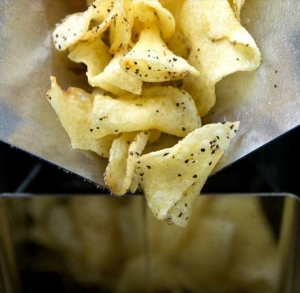 Fresh out of the kettle and still glistening with hot oil, the chips are inspected as they’re transferred up one level to the seasoning room on a vertical conveyor belt, which Cohen affectionately calls “the giraffe.” There, the chips are hand seasoned by two employees before making their way to a scale that weighs the appropriate amounts and drops the chips into bags in the room below. Cohen says when things are running smoothly, they can fill 80 two-ounce bags in a minute. From peeler to bag, the process takes about 14 minutes. “On a good day,” she clarifies with a smile.
Fresh out of the kettle and still glistening with hot oil, the chips are inspected as they’re transferred up one level to the seasoning room on a vertical conveyor belt, which Cohen affectionately calls “the giraffe.” There, the chips are hand seasoned by two employees before making their way to a scale that weighs the appropriate amounts and drops the chips into bags in the room below. Cohen says when things are running smoothly, they can fill 80 two-ounce bags in a minute. From peeler to bag, the process takes about 14 minutes. “On a good day,” she clarifies with a smile.
From recycling potato dirt to selling excess used fryer oil to biofuel producers, Route 11’s production process demonstrates a dedication to incorporating sustainability at every level: “Next on the road is finding packaging that will keep the chips fresh and is also biodegradable,” says Cohen. “That would be a big one for us. Our long term sustainability plan is to keep doing what we’re doing and to control the things we can control.”
Cohen also knows Route 11 chips are for more than just snacking. She also recommends crushing them to use as breading. “It creates a panko-like texture,” she says. Be sure to check out the recipe on our blog for Spicy Potato Chip Breaded Oven Baked Chicken Tenders, created by Friendly City Food Co-op Contributor, Jack Needham.



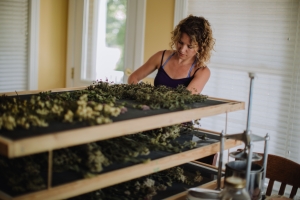 Corey MacDonald and her team at Red Root & Co. are doing something truly unique. Using high quality ingredients from the garden and the forest, they blend tradition and innovation just for your palate. Their delightful herbal infusions are delicious and nourishing.
Corey MacDonald and her team at Red Root & Co. are doing something truly unique. Using high quality ingredients from the garden and the forest, they blend tradition and innovation just for your palate. Their delightful herbal infusions are delicious and nourishing.
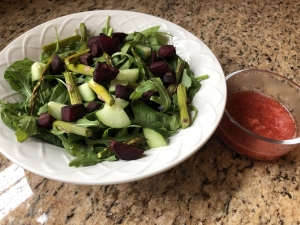
 We’re all hearing about more and more area cities and towns, besides Harrisonburg, who are eliminating curbside recycling. There are many contributing factors, including everything from China’s refusal to continue to accept America’s trash to a greatly reduced need for recycled glass.
We’re all hearing about more and more area cities and towns, besides Harrisonburg, who are eliminating curbside recycling. There are many contributing factors, including everything from China’s refusal to continue to accept America’s trash to a greatly reduced need for recycled glass.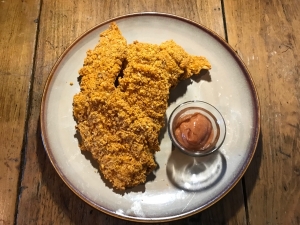
 At their essence, potato chips contain three ingredients: potatoes, oil, and salt. They’re one of America’s favorite snacks year after year, and the crowded market reflects that: countless flavors and varieties, too many brands to count, massive marketing campaigns, and more. So how can a small producer hope to compete? How do they set themselves apart? If you ask Sarah Cohen, President of Route 11 Potato Chips, she’ll say, “Less is more.”
At their essence, potato chips contain three ingredients: potatoes, oil, and salt. They’re one of America’s favorite snacks year after year, and the crowded market reflects that: countless flavors and varieties, too many brands to count, massive marketing campaigns, and more. So how can a small producer hope to compete? How do they set themselves apart? If you ask Sarah Cohen, President of Route 11 Potato Chips, she’ll say, “Less is more.” isolated below the Appalachian Mountains in West Virginia, about 250 miles west of the Route 11 factory. “We were playing around with creating the Salt & Pepper flavor for years,” Cohen says. “There are about 20 salt and pepper chips on the market, most of them containing 15-plus ingredients. Our goal was to do it with just salt and pepper. We just couldn’t find a good balance until we discovered the JQD salt. As soon as we tasted it, we knew . . . We consider this the best flavor we’ve ever developed.”
isolated below the Appalachian Mountains in West Virginia, about 250 miles west of the Route 11 factory. “We were playing around with creating the Salt & Pepper flavor for years,” Cohen says. “There are about 20 salt and pepper chips on the market, most of them containing 15-plus ingredients. Our goal was to do it with just salt and pepper. We just couldn’t find a good balance until we discovered the JQD salt. As soon as we tasted it, we knew . . . We consider this the best flavor we’ve ever developed.” Fresh out of the kettle and still glistening with hot oil, the chips are inspected as they’re transferred up one level to the seasoning room on a vertical conveyor belt, which Cohen affectionately calls “the giraffe.” There, the chips are hand seasoned by two employees before making their way to a scale that weighs the appropriate amounts and drops the chips into bags in the room below. Cohen says when things are running smoothly, they can fill 80 two-ounce bags in a minute. From peeler to bag, the process takes about 14 minutes. “On a good day,” she clarifies with a smile.
Fresh out of the kettle and still glistening with hot oil, the chips are inspected as they’re transferred up one level to the seasoning room on a vertical conveyor belt, which Cohen affectionately calls “the giraffe.” There, the chips are hand seasoned by two employees before making their way to a scale that weighs the appropriate amounts and drops the chips into bags in the room below. Cohen says when things are running smoothly, they can fill 80 two-ounce bags in a minute. From peeler to bag, the process takes about 14 minutes. “On a good day,” she clarifies with a smile.
 We can all agree that supporting the local economy is good for our community. What’s more supportive than owning your own grocery store, which sells products grown and made right here in Virginia?
We can all agree that supporting the local economy is good for our community. What’s more supportive than owning your own grocery store, which sells products grown and made right here in Virginia?
